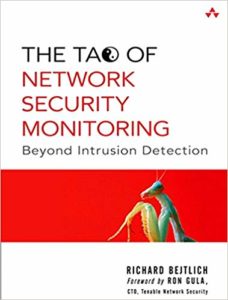 Wow, that was a thick book, the Tao of Network Security Monitoring, beyond intrusion detection from the guru of NSM, Richard Bejtlich. This book is considered the bible of NSM. The book is from 2004 and thus a bit out of date, especially as it is filled with tons and tons of tool, one will find that some of these do not yet exist anymore or development has stopped years ago. But the intention of the book is not to serve as a tool reference but to show which tools are available and what they can be used for. So the brain needs to translate the samples to what tools we have today available. And anyhow in each category we still have enough candidates.
Wow, that was a thick book, the Tao of Network Security Monitoring, beyond intrusion detection from the guru of NSM, Richard Bejtlich. This book is considered the bible of NSM. The book is from 2004 and thus a bit out of date, especially as it is filled with tons and tons of tool, one will find that some of these do not yet exist anymore or development has stopped years ago. But the intention of the book is not to serve as a tool reference but to show which tools are available and what they can be used for. So the brain needs to translate the samples to what tools we have today available. And anyhow in each category we still have enough candidates.
The story line of the book is basically along the different types of network security monitoring data that one can capture along with the tools that provide it:
- full content data (packet capture, e.g. from tcpdump, wireshark)
- Packet headers
- Session or flow data (e.g. from Argus, flow-tools)
- Alert data (e.g. from Bro)
- Statistic data
Bejtlich explains the use of these types of data and the corresponding tools using real-life samples of attacks. This is cool, although following the packet dumps without in-depth protocol knowledge of IP, UDP, TCP, DNS etc. is really a bit hard. Luckily he explains it after the printed dump, so one can be a bit lazy. Probably that is not a good idea, as one missing some learning, but that would probably require a second round of reading.
But the real learning from this book is understanding what a well-configured NSM system and especially stored session data can really give you to detect all kinds of attacks, if you just watch closely enough. The interesting question for me still to answer is how can I transfer this knowledge to cloud-based NSM, where we have some packet capture abilities but all the rest of the tools, how to make use of them in such an environment is left as an exercise.
Summary: definitively worth a read, although it could get an update once a while.
Leave a Reply
You must be logged in to post a comment.